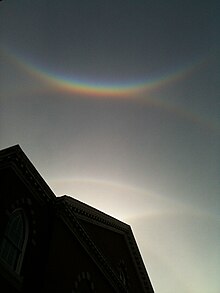
The circumzenithal arc, also called the circumzenith arc (CZA), the upside-down rainbow, and the Bravais arc,[1] is an optical phenomenon similar in appearance to a rainbow, but belonging to the family of halos arising from refraction of sunlight through ice crystals, generally in cirrus or cirrostratus clouds, rather than from raindrops. The arc is located a considerable distance (approximately 46°) above the observed Sun and at most forms a quarter of a circle centered on the zenith. It has been called "a smile in the sky", its first impression being that of an upside-down rainbow. The CZA is one of the brightest and most colorful members of the halo family. Its colors, ranging from violet on top to red at the bottom, are purer than those of a rainbow because there is much less overlap in their formation.
The intensity distribution along the circumzenithal arc requires consideration of several effects: Fresnel's reflection and transmission amplitudes, atmospheric attenuation, chromatic dispersion (i.e. the width of the arc), azimuthal angular dispersion (ray bundling), and geometrical constraints.[2][3] In effect, the CZA is brightest when the Sun is observed at about 20°.
Contrary to public awareness, the CZA is not a rare phenomenon, but it tends to be overlooked, since it occurs so far overhead. It is worthwhile to look out for it when sun dogs are visible, since the same type of ice crystals that cause them are responsible for the CZA.[4]
- ^ "Mémoire sur les halos et les phénomènes optiques qui les accompagnent", J. de l' École Royale Polytechnique 31(18), 1-270, A. Bravais, 1847
- ^ "Frequency analysis of the circumzenithal arc: Evidence for the oscillation of ice-crystal plates in the upper atmosphere," J. Opt. Soc. Am. 69(8), 1119–1122 (1979)
- ^ Cite error: The named reference
artificial-circumhorwas invoked but never defined (see the help page). - ^ "Circumzenithal Arc". www.atoptics.co.uk. 16 September 2023.